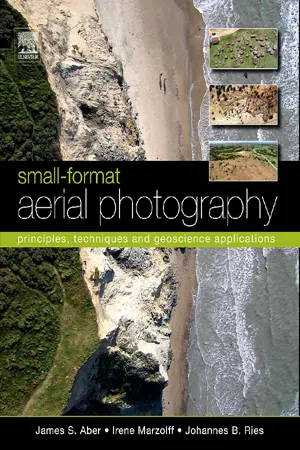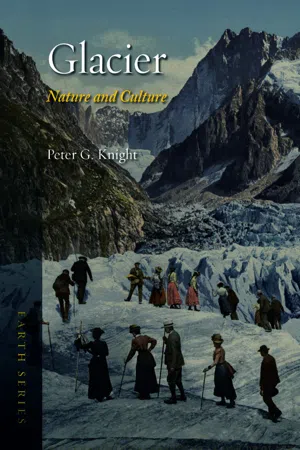Glacial Landforms
Glacial landforms are physical features created or influenced by the movement and melting of glaciers. These landforms include U-shaped valleys, cirques, moraines, and drumlins, among others. Glacial landforms are important in understanding past and present glacial activity and can provide valuable insights into the Earth's history and climate changes.
5 Key excerpts on "Glacial Landforms"
- eBook - ePub
Small-Format Aerial Photography
Principles, Techniques and Geoscience Applications
- James S. Aber, Irene Marzolff, Johannes Ries(Authors)
- 2010(Publication Date)
- Elsevier Science(Publisher)
...Chapter 12 Glacial Geomorphology 12.1. INTRODUCTION Modern glaciers and ice sheets cover approximately 10% of the world’s land area. Of this, most glacier ice is found in Antarctica and Greenland with all other areas accounting for only about 5% of the total. During the Ice Age (Pleistocene Epoch) of the last one million years, glaciers and ice sheets expanded dramatically and repeatedly over large portions of northern Eurasian and North American lowlands and in mountains and high plateaus around the world. At times, the volume of glacier ice during the Pleistocene was at least triple that of today (Hughes et al., 1981). Global sea level declined by at least 120 m, which allowed ice sheets to spread over broad continental shelves, particularly north of Eurasia (Svendsen et al., 1999; Polyak et al., 2000). Geomorphology is the study of the Earth’s surficial landforms both on land and on the seafloor. This study is both descriptive and quantitative; it deals with morphology, processes, and origins of landforms. Glacier ice is a powerful agent that created many distinctive landforms that are well preserved nowadays in regions of former ice expansion. Glaciers modify the landscape in three fundamental ways by erosion, deposition, or deformation (Fig. 12-1). A given site may be subjected to each or all of these processes during the advance and retreat of a glacier, and repeated glaciation may overprint newer landforms on older ones. In addition, glacial meltwater is also an effective geomorphic agent that may erode or deposit conspicuous landforms in connection with glaciation. The results are complex landform assemblages that represent multiple glaciations during the Pleistocene. Aerial photography has long been utilized to illustrate, describe, interpret, and map the diverse types of landforms created by glaciation (e.g. Gravenor et al., 1960)...
- eBook - ePub
- Simon Bell(Author)
- 2012(Publication Date)
- Routledge(Publisher)
...Ice continues to erode high mountains and parts of some lands such as Iceland, Greenland and Antarctica (Figure 6.18). The erosive power of ice is very great, ranging from the widespread effects of continental ice sheets many hundreds of metres thick to major and minor valley and corrie glaciers, gouging out large valleys as well as eroding rock surfaces at the small scale. At a grand scale, the interaction of ice sheet movement across the ancient Precambrian rocks of the vast Canadian Shield and northern Siberia left behind an undulating topography. From 10,000 metres high, travelling in a transcontinental airliner, the view shows a defi- nite grain or directional pattern to large areas of this tundra, land where the subsoil remains permanently frozen (Figure 6.19). The pattern partly reflects the directional flow of the ice and the underlying rock structure, where weaknesses have been exploited by the ice. This erosive landform also contains depositional patterns of drumlins (linear deposits of eroded material). This extensive pattern has had a major effect on the drainage pattern and microclimate affecting vegetation distribution. In order to see the way in which the process of glaciation works under different conditions, such as latitude, elevation and aspect, it is useful to examine an area where all of these variables can be observed. Such a place is the Cascade Mountains, running from California northwards to British Columbia, which were discussed earlier in relation to landform creation through plate tectonics and vulcanism. The Cascade Mountains contain many peaks high enough to accumulate sufficient snow to compress into a hard-packed form (firn) that eventually turns into granular ice, under the pressure of its own weight, and starts to flow downhill under gravity. For example, Mount Rainier supports twenty-six glaciers, each of which is the source of a major river in the region...
- eBook - ePub
- Rattan Lal(Author)
- 2017(Publication Date)
- CRC Press(Publisher)
...Land Forms Carolyn G. Olson National Leader Soil Survey Investigations, Lincoln, Nebraska, U.S.A. Abstract Landforms are features of the earth that together comprise the land surface. They may be of large features, such as plains, plateaus, or mountains, or smaller features, such as hills, eskers, or hillslopes. There are several ways to describe a landform. Surface form is the most common method of description and includes an analysis of shape factors. Early classification generally falls into the following five categories: genetic, process, size, topographic expression (morphology), and degree of erosion. INTRODUCTION Landforms are features of the earth that together comprise the land surface. They may be of large features, such as plains, plateaus, or mountains, or smaller features, such as hills, eskers, or hillslopes. The glossary of geology defines a landform as “any physical, recognizable form or feature of the earth’s surface having a characteristic shape and produced by natural causes.” [ 1 ] A similar definition for landform can be found in almost any geology or geomorphology textbook. The word “landform” is derived from the Old English or Old German word land and the Latin forma. [ 2 ] DESCRIPTION AND MORPHOMETRY There are several ways to describe a landform. Surface form is the most common method of description and includes an analysis of shape factors. Shape is characterized by breaks and changes of slope, directions and angles of maximum slope, and other similar information. A minimum of three parameters are used to describe slope shape:1) slope length or vertical curvature; 2) slope width or horizontal curvature; and 3) gradient. Slope length is measured by a radial that crosses topographic contour lines at right angles. This dimension is sometimes referred to as a longitudinal profile. Slope width, measured perpendicular to the slope length, parallels topographic contour lines...
- eBook - ePub
Glacier
Nature and Culture
- Peter G. Knight(Author)
- 2019(Publication Date)
- Reaktion Books(Publisher)
...1 Ways of Thinking about Glaciers A perennial mass of ice, and possibly firn and snow, originating on the land surface by the recrystallization of snow or other forms of solid precipitation and showing evidence of past or present flow. 1 Today, from a distance, I saw you walking away, and without a sound the glittering face of a glacier slid into the sea. 2 Precisely defined for the scientist, a metaphor and an icon for the poet, glaciers for each of us have their own place in our view of the world. Human life has developed in an unusual period of Earth’s history: a period in which there are glaciers. Of the history of the planet, glaciers have been here, on and off, for only about 15 per cent of the time, but they have been here throughout the 2 million years of human history and prehistory. However, only for the last century have we lived in an age in which the importance of glaciers has been acknowledged. It is less than two hundred years since the idea was first widely accepted that ice ages come and go, and that glaciers used to cover much more of the Earth’s surface than they do now. We have only just noticed that we are living in a glacial period. We live now, for the first time, in a cultural ice age as well as a physical one. Few of us consciously place ‘glacier’ at the heart of our view of the world but we do now appreciate the key role of glaciers both in the planet’s past – creating the landscapes that surround us – and in its future, as major players in the unfolding drama of climate change. But at the same time that we noticed glaciers we also realized that the physical ice age may be coming to an end, that we are losing the glaciers, and that it may be our fault that we are losing them so fast. Because we recognize the importance of glaciers in the global system we now have a particular view of the world, different from that of the generations before us...
- eBook - ePub
Landscape Grading
A Study Guide for the LARE
- Valerie E. Aymer(Author)
- 2020(Publication Date)
- Routledge(Publisher)
...Section Two Landforms 2.1 What are landforms? Landforms are the identifiable shapes that the earth naturally forms due to geological processes. As landscape architects, we mimic and manipulate these basic forms to create functional designs. The natural shapes we are most concerned with are plane surfaces, ridges, valleys, peaks and depressions. These are manifested differently throughout the world and are named by their vegetative and animal habitats. For example, a bog, a swamp, and a fen are different types of wetlands. The processes that form and sustain these different wetlands vary; and the types of bog, swamp, and fen vegetation varies, but the underlying shape they form is a depression, a low point in the topography. It is the underlying landform in all cases that we manipulate in landscape grading. These natural forms are most easily recognized on a larger scale (e.g. 100, 200, 500 scale). However, because these problems are at such a large scale, intricate grading is difficult. Identification of the landforms, knowing where to put the problem elements and calculating slope between contour lines becomes essential. 2.2 Watersheds Together, plane surfaces, ridges, valleys, peaks, and depressions form watersheds. A watershed is a natural drainage basin for a particular area. It carries surface runoff, water from rainfall events, from the highest regions of the watershed downhill until it collects in streams, rivers, ponds, and eventually the ocean. Watersheds can be divided into subdrainage basins where water flows to a particular stream or pond within a watershed or they can be linked together to form a larger watershed region. These larger watershed regions are not determined by state government boundaries, but often encompass several states or more than one country. Additional information about watershed processes can be found in the recommended reading...




